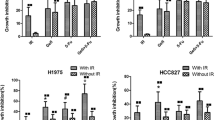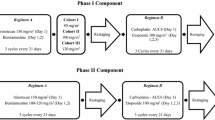Abstract
Purpose
ABT-751 is an orally active antimitotic agent that is currently in Phase II clinical trials. This agent binds to the colchicine site on ß-tubulin and inhibits polymerization of microtubules. This disruption of microtubule dynamics leads to a block in the cell cycle at the G2/M phase, and promotes apoptosis. ABT-751, as a single agent, has antitumor activity against a series of xenograft models including non-small cell lung cancer (NSCLC) and colon cancer. The current studies were conducted to determine whether ABT-751 enhances antitumor activity of standard cytotoxic therapies currently in clinical use.
Methods
Efficacy of ABT-751, in combination with cisplatin, 5-FU, and radiation, was evaluated in the Calu-6 NSCLC, HT-29 colon, and HCT-116 colon carcinoma xenograft models, respectively. Tumor-bearing athymic mice were treated with ABT-751 orally once a day at 75 or 100 mg/kg/day on a 5-days-on, 5-days-off schedule for two cycles.
Results
Efficacy of ABT-751 at 100 mg/kg/day was tested in combination with cisplatin at its maximum tolerable dose (MTD) (10 mg/kg/day, i.p. x1) in Calu-6 tumor-bearing athymic mice. The percent treated/control (%T/C) tumor volume ratios on day 38 were 35, 37, and 6, and the percent tumor growth delay (%TGD) values were 71, 65, and 188 for cisplatin, ABT-751 and the combination groups, respectively. HT-29 colon tumors were used to test ABT-751 in combination with an MTD of 5-FU, 30 mg/kg/day, i.p., q.d. x5. The %T/C ratios on day 38 were 22, 28, and 5 and the %TGD values were 75, 75, and 150 for 5-FU, ABT-751, and the combination groups, respectively. Treatment of HCT-116 colon carcinoma tumors with ABT-751, concurrent with the radiation treatment, was able to both enhance radiation-induced tumor regression, and delay the time to recurrence and progression. Growth curves allowed calculation of enhancement of radiation-induced growth delay (defined as the additional time required for a treated tumor to reach four times its original size) of 2, 9, and 12 days, for ABT-751 alone, radiation alone, and the combination, respectively.
Conclusion
Collectively, these studies demonstrate that ABT-751 enhanced efficacy of standard cytotoxic therapies in a variety of tumor xenograft models, and that enhancement was at least additive in all systems.




Similar content being viewed by others
References
Bunz F, Dutriaux A, Lengauer C, Waldman T, Zhou S, Brown JP, Sedivy JM, Kinzler KW, Vogelstein B (1998) Requirement for p53 and p21 to sustain G2 arrest after DNA damage. Science 282:1497–1501
Carlson DM, Steinberg JL, Gordon GB (2005) Targeting the unmet medical need: the Abbott Laboratories oncology approach. Clin Adv Hematol Oncol 3:703–710
Chan TA, Hermeking H, Lengauer C, Kinzler KW, Vogelstein B (1999) 14-3-3s is required to prevent mitotic catastrophe after DNA damage. Nature 401:616–620
Taxotere-Patient Information Leaflet [http://www.accessdata.fda.gov/scripts/cder/drugsatfda/index.cfm?fuseaction = Search.Label_ApprovalHistory#apphist]
Fox E, Adamson PC, Hagey A, Widemann BC, Maris JM, Cohn SL, Cai Y, Medina DM, Meek KA, Balis FM, et al (2005) Phase I trial of oral ABT-751 in pediatric patients: preliminary evidence of activity in neuroblastoma (NBL). J Clin Oncol 23:8527
Hall EJ (2000) Radiobiology for the radiologist, 5th edn. Lippincott Williams & Wilkins, New York
Hermeking H, Lengauer C, Polyak K, He TC, Zhang L, Thiagalingam S, Kinzler KW, Vogelstein B (1997) 14-3-3 sigma is a p53-regulated inhibitor of G2/M progression. Mol Cell 1:3–11
Jordan MA, Wilson L (1998) Microtubules and actin filaments: dynamic targets for cancer chemotherapy. Curr Opin Cell Biol 10:123–130
Jordan MA, Wilson L (1998) Use of drugs to study role of microtubule assembly dynamics in living cells. Methods Enzymol 298:252–276
Jordan MA, Wilson L (2004) Microtubules as a target for anticancer drugs. Nat Rev Cancer 4:253–265
Kelner MJ, McMorris TC, Rojas RJ, Trani NA, Velasco TR, Estes LA, Suthipinijtham P (2002) Enhanced antitumor activity of irofulven in combination with antimitotic agents. Invest New Drugs 20:271–279
Koyanagi N, Nagasu T, Fujita F, Watanabe T, Tsukahara K, Funahashi Y, Eisai, California, Exp. Cancer-Chemother. Res. Lab., University of Osaka, California (1994) In vivo tumor growth inhibition produced by a novel sulfonamide, E7010, against rodent and human tumors. Cancer Res 54:1702–1706
Li CJ, Li YZ, Pinto AV, Pardee AB (1999) Potent inhibition of tumor survival in vivo by beta-lapachone plus taxol: combining drugs imposes different artificial checkpoints. Proc Natl Acad Sci USA 96:13369–13374
Li Q, Sham HL, Rosenberg SH (1999) Antimitotic agents. Annu Rep Med Chem 34:139–148
Luo Y, Mohning KM, Nuss ME, Hradil VP, Joseph IB, Frost DJ, Sham HL, Rosenberg SH, Reinhart GA, Cox BF (2002) A novel anti-tubulin agent (ABT-751) selectively reduces tumor perfusion in a subcutaneous rat tumor model as measured by MRI. In: Proceedings of the American Association for Cancer Research 93rd Annual Meeting, 6–10 April 2002, San Francisco, CA, USA
Raynaud FI, Judson IR (1996) Synthetic microtubule inhibitors. Drugs Future 21:65–70
Rowinsky EK, Donehower RC (1997) Pharmacology of cancer chemotherapy: antimicrotubule agents. In: DeVita VT, Hellman S, Rosenberg SA (eds) Cancer: principles and practice of oncology. Lippincott-Raven, Philadelphia, pp 467–483
Rowinsky EK (1997) The development and clinical utility of the taxane class of antimicrotubule chemotherapy agents. Annu Rev Med 48:353–374
Segreti JA, Polakowski JS, Koch KA, Marsh KC, Bauch JL, Rosenberg SH, Sham HL, Cox BF, Reinhart GA (2004) Tumor selective antivascular effects of the novel antimitotic compound ABT-751: an in vivo rat regional hemodynamic study. Cancer Chemother Pharmacol 54:273–281
Teicher BA, Alvarez E, Liu P, Lu K, Menon K, Dempsey J, Schultz RM (1999) MTA (LY231514) in combination treatment regimens using human tumor xenografts and the EMT-6 murine mammary carcinoma. Semin Oncol 26:55–62
Tian H, Wittmack EK, Jorgensen TJ (2000) p21WAF1/CIP1 antisense therapy radiosensitizes human colon cancer by converting growth arrest to apoptosis. Cancer Res 60:679–684
Waldman T, Kinzler KW, Vogelstein B (1995) p21 is necessary for the p53-mediated G1 arrest in human cancer cells. Cancer Res 55:5187–5190
Waldman T, Lengauer C, Kinzler KW, Vogelstein B (1996) Uncoupling of S phase and mitosis induced by anticancer agents in cells lacking p21. Nature 381:713–716
Waldman T, Zhang Y, Dillehay L, Yu J, Kinzler K, Vogelstein B, Williams J (1997) Cell-cycle arrest versus cell death in cancer therapy. Nature Med 3:1034–1036
Yamamoto K, Noda K, Yoshimura A, Fukuoka M, Furuse K, Niitani H (1998) Phase I study of E7010. Cancer Chemother Pharmacol 42:127–134
Yoshimatsu K, Yamaguchi A, Yoshino H, Koyanagi N, Kitoh K (1997) Mechanism of action of E7010, an orally active sulfonamide antitumor agent: inhibition of mitosis by binding to the colchicine site of tubulin. Cancer Res 57:3208–3213
Acknowledgments
This work was funded in part by a contract to KARD Scientific and Georgetown University from Abbott Laboratories. The authors thank Dr. Gary B. Gordon for helpful discussions.
Author information
Authors and Affiliations
Corresponding author
Rights and permissions
About this article
Cite this article
Jorgensen, T.J., Tian, H., Joseph, I.B.J.K. et al. Chemosensitization and radiosensitization of human lung and colon cancers by antimitotic agent, ABT-751, in athymic murine xenograft models of subcutaneous tumor growth. Cancer Chemother Pharmacol 59, 725–732 (2007). https://doi.org/10.1007/s00280-006-0326-2
Received:
Accepted:
Published:
Issue Date:
DOI: https://doi.org/10.1007/s00280-006-0326-2




